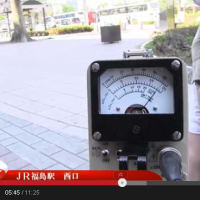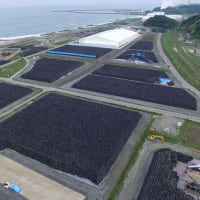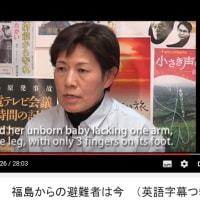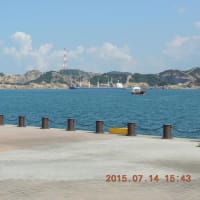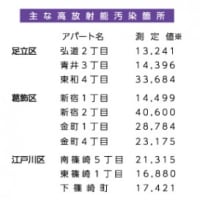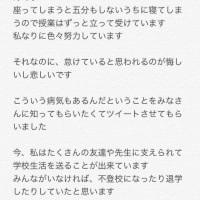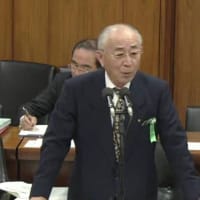小豆川東大助教の「飯舘村でネプツニウム(プルトニウム239親核種)検出」研究論文
2011年3月11日の東日本地震大震災は福島第一原発の原子炉冷却系を破損しました。
その後の水素爆発は、環境中へ原子炉格納容器から放射性核種が大量放出されました。
私たちは、2011年4月10日発電所正門の前、および35km離れた飯館村で、ガンマ線を測定しました。
私たちは放射化生成物(239Npおよび59Fe)および核分裂生成物(131I、134Cs(133Cs)、137Cs、110mAg(109Ag)、132Te、132I、140Ba、140La、91Sr、91Y、95Zrおよび95Nb)を検出しました。
239Npは239Puの親核種です。
59Feについては、冷却管の腐食によって得られた58Feの放射化生成物と推測されます。
結果は次のことを示します、事故の一か月以内に拡散されたこれらの活性化および核分裂生成物であると。
The Great Eastern Japan Earthquake on March 11, 2011, damaged reactor cooling systems at Fukushima Dai-ichi nuclear power plant. The subsequent venting operation and hydrogen explosion resulted in a large radioactive nuclide emission from reactor containers into the environment. Here, we collected environmental samples such as soil, plant species, and water on April 10, 2011, in front of the power plant main gate as well as 35 km away in Iitate village, and observed gamma-rays with a Ge(Li) semiconductor detector. We observed activation products (239Np and 59Fe) and fission products (131I, 134Cs (133Cs), 137Cs, 110mAg (109Ag), 132Te, 132I, 140Ba, 140La, 91Sr, 91Y, 95Zr, and 95Nb). 239Np is the parent nuclide of 239Pu; 59Fe are presumably activation products of 58Fe obtained by corrosion of cooling pipes. The results show that these activation and fission products, diffused within a month of the accident.
転載元:http://blade1024.blog.fc2.com/blog-entry-13.html ↓↓↓↓
東大・大学院総合文化研究科の小豆川勝見助教による原発周辺での調査が、海外論文としてEnvironmental Pollution誌に掲載されている。
"Deposition of fission and activation products after the Fukushima Dai-ichi nuclear power plant accident"である。
残念ながら購読は有料となっており、Abstractのみ閲覧できる。(以下に抜粋)
Abstract
The Great Eastern Japan Earthquake on March 11, 2011, damaged reactor cooling systems at Fukushima Dai-ichi nuclear power plant. The subsequent venting operation and hydrogen explosion resulted in a large radioactive nuclide emission from reactor containers into the environment. Here, we collected environmental samples such as soil, plant species, and water on April 10, 2011, in front of the power plant main gate as well as 35 km away in Iitate village, and observed gamma-rays with a Ge(Li) semiconductor detector. We observed activation products (239Np and 59Fe) and fission products (131I, 134Cs (133Cs), 137Cs, 110mAg (109Ag), 132Te, 132I, 140Ba, 140La, 91Sr, 91Y, 95Zr, and 95Nb). 239Np is the parent nuclide of 239Pu; 59Fe are presumably activation products of 58Fe obtained by corrosion of cooling pipes. The results show that these activation and fission products, diffused within a month of the accident.
--------------------------------------------------------------------------------
Highlights
► We collected environmental samples near the Fukushima nuclear power plant. ► We observed 239Np and 59Fe along with many fission products. ► 239Np is evidently an activation product of 238U contained in nuclear fuel. ► 239Np is also parent nuclide of 239Pu. ► Our results show that activation products diffused within a month of the accident.
これらは小豆川助教が昨年4月10日に現地入りし、原発周辺の空間線量や土壌・直物分析を行ったものである。
特に飯館村の土壌分析による核種の分析結果では、プルトニウムの親核種であるネプツニウム(239Np)が検出され事故当初の貴重なデータとなっている。
この分析結果の一部は、昨年7月2日に東大・駒場の勉強会で公開されている。
その後、昨年9月に「おしどりマコ&ケン」取材により日刊SPA!で掲載され、文科省がプルトニウムの汚染MAPを公開するまでに至った経緯がある。
当時は「既にネプツニウムはプルトニウムへ壊変し、その半減期からベクレル数は何万分の1程度になっているので不安を煽るな!」と言う御用学者らの風潮で揉み消されてきた。
本来は「事故当初、どれだけ危険な放射線核種がバラ撒かれ、住民が危険に晒されているのか?」の証明であった。
これまで国内での公表は、海外論文の査読に長時間待たされ非公開となっていたが、海外で公表されたことで解禁となったわけである。
以下に昨年7月2日に東大・駒場の勉強会で使われた資料の一部を掲載する。
(※注)当初、コバルト60が検出されたと報告があったが、勉強会後の再評価では未検出と訂正されている為、修正を加えている。
検出されたセシウム・ネプツニウム以外の核種の多くは半減期が短く、故に崩壊エネルギーが高い核種であった。
その量もさることながら、今では検出不可能な核種ばかりであった。
調査を行ったのは4月10日、事故後30日を経過していながらも短寿命の核種が多数検出されている事に驚く。
4月上旬でも、まだ大量の放出が続いていたのであろうが、半減期を考慮し逆算するだけでも事故直後の降下量は想像を絶するものになりそうだ。
また今回検出されたものは全て「弱β線核種(β-)」であるので、WBCなどのガンマ線検査機では実際の被曝量などは測れていないはずである。
事故当初、周辺住民はどれだけの核種と量を取り込んでしまったのだろうか・・・背筋が凍る思いだ。
検出された核種の壊変ならびに半減期などを記載しておく。
また安定後でも、カドミウム・モリブデン・コバルトなどの危険物質のままである事に注意。
I-131→(β-、半減期8.0日)→Ba-134(安定)
Cs-134→(β-、半減期2.1年)→Xe-131(安定)
Cs-137→(β-、半減期30.2年)→Ba-137(安定)
Ag-110m→(β-、半減期250.0日)→Cd-110(安定)※カドミウム
Te-132→(β-、半減期3.2日)→I-132→(β-、半減期2.3時間)→Xe-132(安定)
Ba-140→(β-、半減期12.8日)→La-140(安定)
La-140→(β-、半減期1.7日)→Ce-140(安定)
Sr-91→(β-、半減期9.6時間)→Y-91→(β-、半減期58.5日)→Zr-91(安定)
Y-91→(β-、半減期58.5日)→Zr-91(安定)
Zr-95→(β-、半減期64.0日)→Nb-95→(β-、半減期35.0日)→Mo-95(安定)※モリブデン
Nb-95→(β-、半減期35.0日)→Mo-95(安定)※モリブデン
Np-239→(α+β-、半減期2.4日)→Pu-239→(α、半減期24125年)→U-235・・・・
Fe-59→(β-、半減期44.5日)→Co-59(安定)※コバルト
■参考資料
東大・駒場の勉強会資料 2011.7.2(PDF)
文科省「福島県における土壌の放射線モニタリング(プルトニウム)調査結果」










